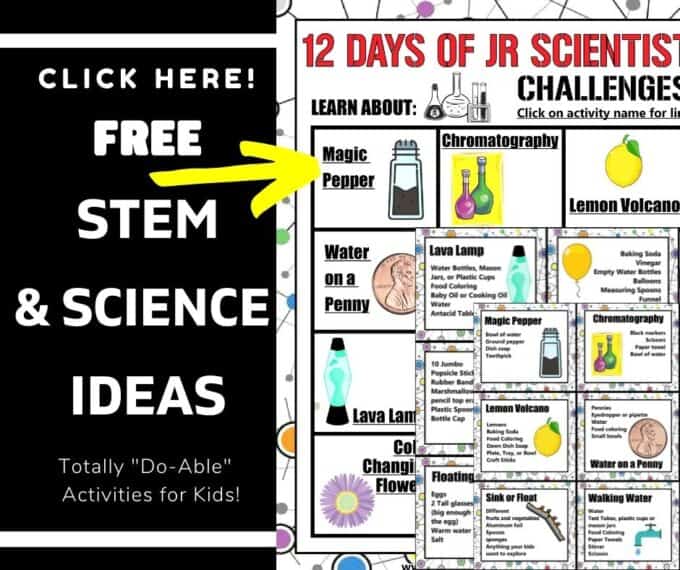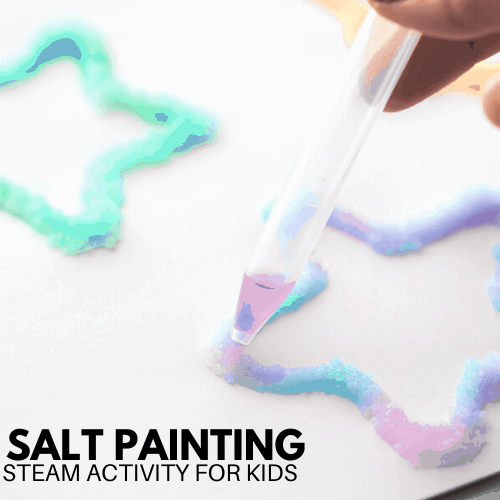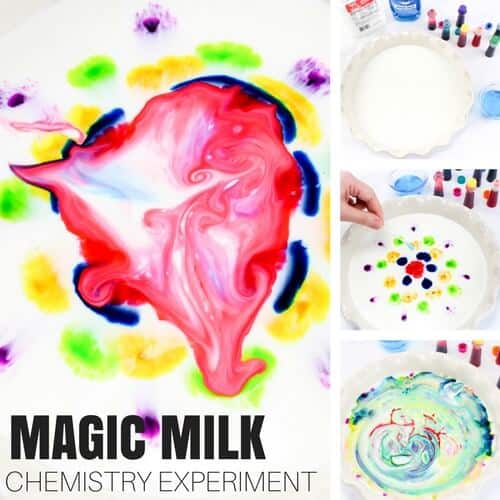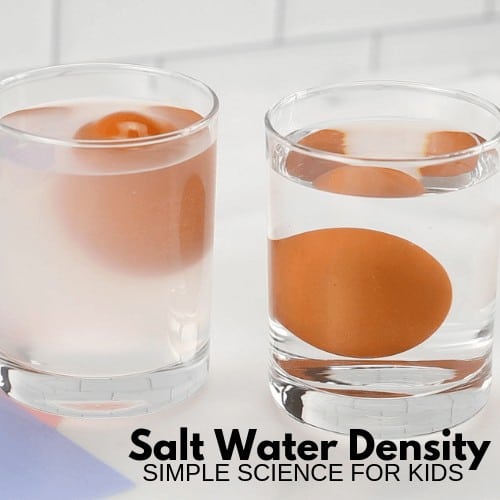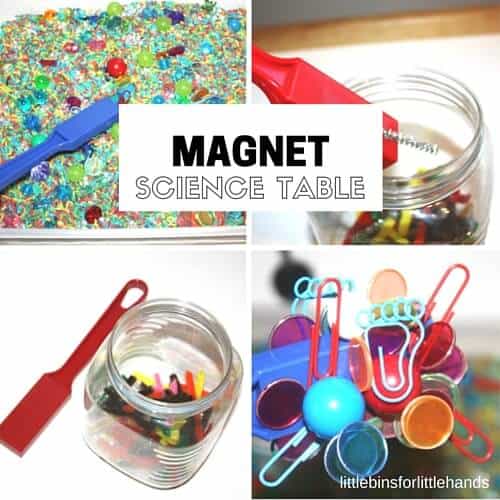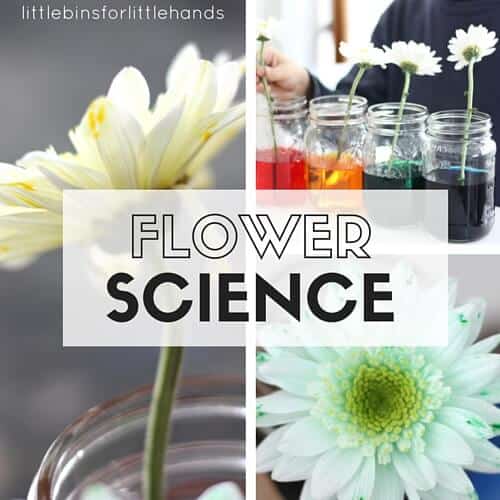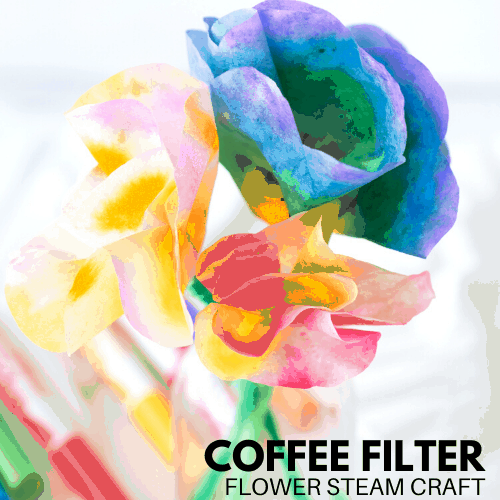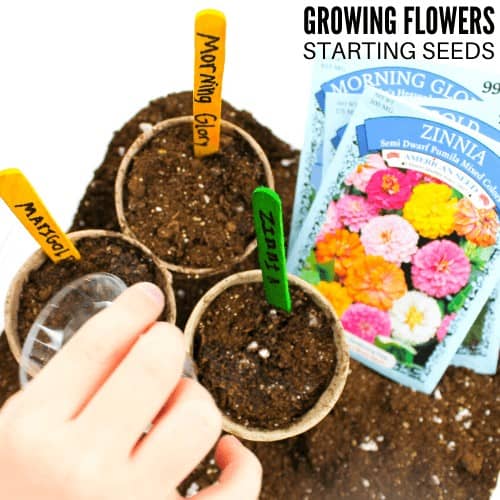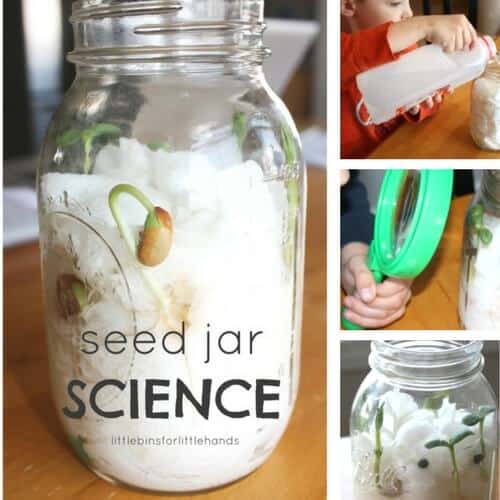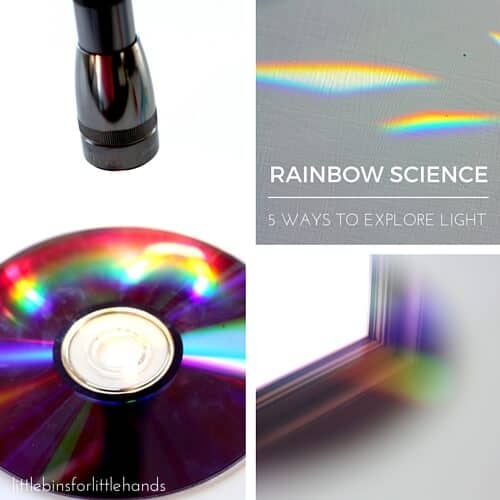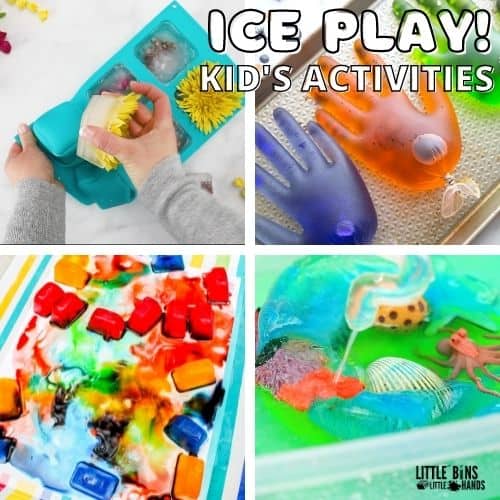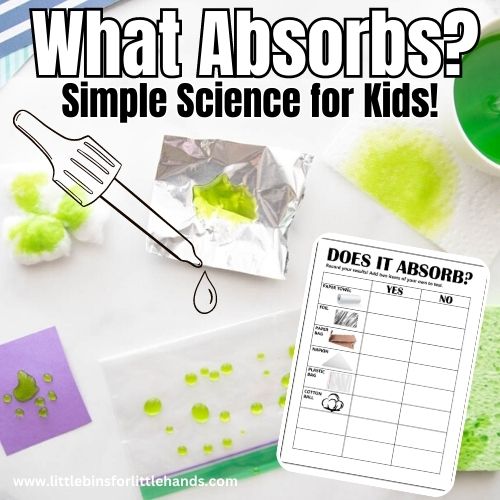Curious kids turn into junior scientists with these fun and simple science experiments for kindergarten. Science doesn’t need to be difficult or complicated for our younger kiddos! Here’s our list of the best kindergarten science activities that are totally doable and use simple supplies for home or in the classroom.
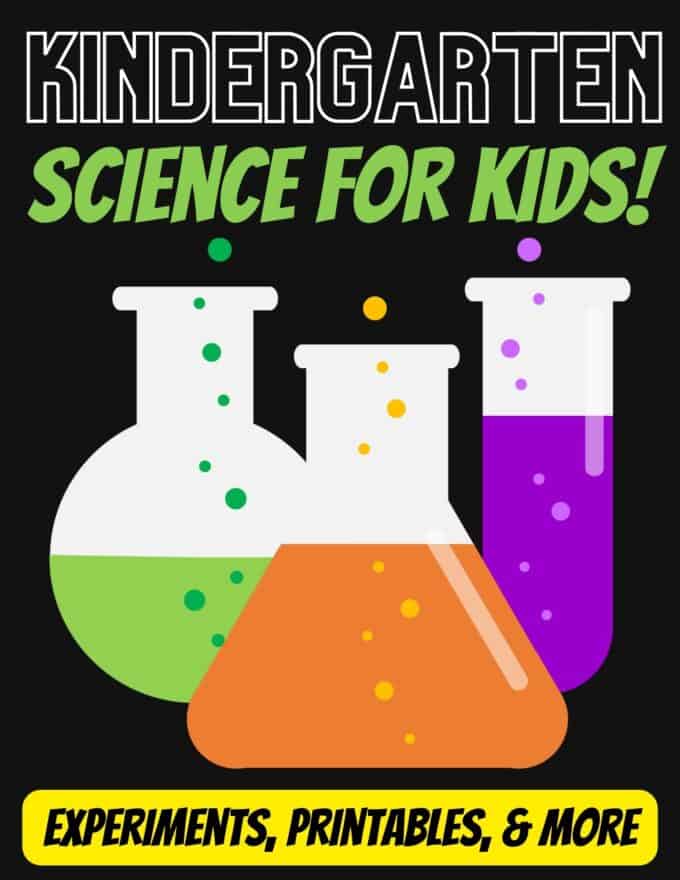
How to Teach Science to Kindergarten
Kindergarten is actually the craziest thing! If you take a minute to stop and think about it. It’s wild to me that we ask 4, 5 and 6-year-olds to come to school, sit quietly, and learn things like foundational science concepts.
This is coming from me, a former kindergarten teacher! I can’t imagine how parents feel sending their kiddos off and having them come home talking about the STEAM design process, ecosystems, and weather patterns. Kids understand it, and even more, they LOVE it!
These little ones are sponges. Things like STEAM or STEM and the NGSS standards actually help us as teachers tap into how they learn best – by doing and being hands-on with their learning. Our kinders are also playful, curious and inquisitive.
Encourage Curiosity, Experimentation and Exploration
There is much you can teach your kindergarten kids in science. Keep the activities playful and simple as you mix in a little of the “science” along the way.
These science activities below are great for short attention spans. They are almost always hands-on, visually engaging, and filled with play opportunities!
Not only are these science activities an excellent introduction to higher learning concepts, but they also spark curiosity. Encourage your kids to ask questions, solve problems, and find answers.
Science learning in kindergarten encourages young kids to make observations with the five senses, including sight, sound, touch, smell, and sometimes even taste. When kids are fully able to immerse themselves in the activity, the greater the interest they will have in it!
Kids are naturally curious creatures, and once you have piqued their curiosity, you have also turned on their observation, critical thinking, and experimenting skills.
Kids will naturally start to pick up on the simple science concepts presented just by having a fun conversation about it with you!
Kindergarten Science Standards Simplified
Much of what surrounds your kids every day is what makes up a good portion of the kindergarten science standards.
TIP 1: Play With Toys
The first thing a K teacher should do to get their students into NGSS is to start with toys and play! Gather yo-yos, toy cars and ramps/tracks, blocks, a wagon, marbles, etc and get the students playing.
We know young children learn best through play, so let’s use that to our advantage. How will playing help them learn science concepts?
Well the specific toys suggested above will all help students learn about forces and motion, pushes and pulls. This is a specific set of standards NGSS includes for the grade!
Now that your students are playing, talk to them about what is happening with the toys. Ask them questions like “what might happen if I push this faster?” “What about if I pull it slower?” You can foster conversation surrounding the play and the concepts! Then check those standards off your list! Easy enough right?!
TIP 2: Favorite Animals
Another suggestion I can make for K teachers diving into the world of science with their students is to use little kids’ love of animals to your advantage too! I have yet to meet a little one who doesn’t have a favorite animal! They can spout endless facts about on-demand. Kids LOVE animals!
Ask each student what his/her favorite animal is and what it eats, and you’re halfway there. You can talk about plants getting food from the soil, sun, and water!
TIP 3: Tricky Topics
You’re thinking, “ok, so far so good, but now I see that the NGSS standards want me to teach ‘Earth’s Systems’ to 5 year-olds and we’re not even sure that meteorologists understand ‘Earth’s systems’”. Have no fear!
All this means is we need to talk to our students about and make observations about the weather where we live. We can tie this into graphing and math, as many of us already do in our morning meetings, and we’re meeting some of the standards.
You can ask the students to have a dress-up day (who doesn’t love a good theme day!) and represent clothing needed for certain kinds of weather. Guess what? You’re meeting some of the standards!
Talk about the number of sunny days, cloudy days, rainy days in a month and compare the temperatures (warm/cool) from that length of time.
TIP 4: Integrate Topics
The final bundled of NGSS standards created for kindergarten is the group called “Earth and Human Activity”. This unit is going to bring your plant/animal learning and your weather discussions together!
To meet these standards you can begin to introduce the concept of food chains to the kids. You can talk more about what animals eat, what they need to survive, and how that changes or effects where the animals live.
This includes humans too! You can also discuss more why we have forecasters and why predicting the weather is important. (Take it back to your dress-up day and you’re set!)
Lastly, you can talk to students about conservation, recycling and protecting the earth to meet the final standard in this bundle. I have yet to meet a teacher that doesn’t do something with their students for Earth Day, be it a read-aloud, craft or picking up trash from the playground.
Take this conversation a tad deeper than you normally would and realize that not only did you just do some awesome hands-on teaching and integration, but you also just nailed the NGSS standards!
Kindergarten Science Topics
Kindergarten science introduces young learners to basic scientific concepts through hands-on activities and simple observations. Here are some common science concepts that kindergarteners may learn in the classroom:
Five Senses: Understanding and exploring the five senses – sight, hearing, touch, taste, and smell. Activities might involve identifying and categorizing objects based on sensory experiences.
Living vs. Non-living: Differentiating between living and non-living things. Students may explore plants, animals, and objects to understand the characteristics of living organisms.
Seasons: Recognizing and understanding the four seasons and their characteristics. Activities may include observing changes in the weather, trees, and clothing.
Weather: Introducing basic weather concepts such as sunny, rainy, cloudy, windy, and snowy. Students may engage in weather-related observations and discussions.
Day and Night: Understanding the concept of day and night, and the rotation of the Earth. Activities might include observing the sky during different times of the day.
Basic Plant Parts: Introducing the basic parts of a plant, such as roots, stems, leaves, flowers, and seeds. Simple plant-growing experiments may be conducted.
Animals and their Habitats: Learning about different animals and their habitats. This may include discussions about where animals live and what they eat.
Basic Measurement: Introduction to basic measurement concepts, such as big/small, tall/short, long/short. Students may use non-standard units for measurement.
Sink and Float: Exploring the concept of buoyancy by observing and experimenting with objects that sink or float in water.
Magnets: Introducing the basic properties of magnets, such as attraction and repulsion. Students may explore objects that are attracted to magnets.
Life Cycle: Exploring the life cycle of simple organisms, such as butterflies, frogs, or plants. Activities may involve sequencing the stages of a life cycle.
Helpful Science Resources
Here’s a list of more helpful resources you will want to check out. Plan a year of science using all our ideas, and you will have an awesome year of learning!
- Preschool Science Center Ideas
- Make a homemade science kit that’s inexpensive!
- Preschool Science Experiments
- 100 STEM Projects For Kids
- Scientific Method For Kids With Examples
- FREE Printable Science Worksheets
- STEM Activities For Toddlers
BONUS!! Check out our spooky Halloween Science Experiments!
Free Printable Science Activities Calendar
Easy Science Experiments For Kindergarten
Are science activities easy to do with young kids? You bet! The science activities you find here are inexpensive, as well as quick and easy to set up!
Many of these awesome kinder science experiments use common ingredients you may already have. Just check your kitchen cupboard for cool science supplies.
Describe An Apple Using The 5 Senses
The 5 senses are a great way for younger kids to practice their observation skills. Get kids to examine, explore, and of course taste the different varieties of apples to find out which apple is the best. Use our handy free 5 senses worksheet to extend the lesson for kids ready to journal their science experiments.
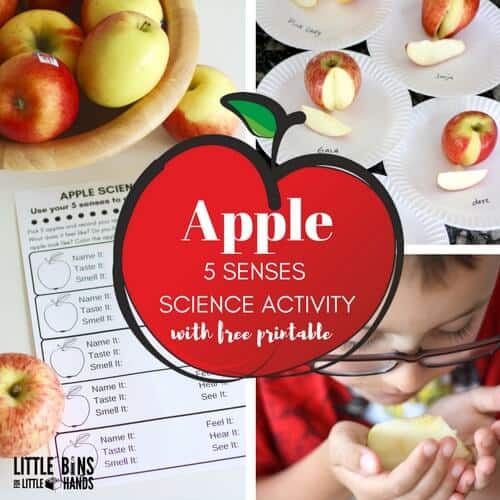
Salt Painting
Combine science and art to learn about absorption with this easy salt painting activity. All you need is a little imagination, glue, and salt!
Magic Milk Experiment
The chemical reaction in this magic milk experiment is fun for kids to watch and makes for great hands-on learning. The perfect science activity as you already have all the items for it in your kitchen.
Sink or Float
Grab some common every day items and test whether they sink or float in water. An easy science activity to introduce the concept of buoyancy to our kindergarteners.
Egg In Salt Water
Will an egg float or sink in salt water? This is a fun version of the sink or float activity above. Ask lots of questions and get kids thinking with this salt water density experiment.
Oobleck
Is it a liquid or is it a solid? Fun hands-on science and play with our easy 2 ingredient oobleck recipe.
Magnet Discovery Table
Exploring magnets makes for an awesome discovery table! Discovery tables are simple low tables set up with a theme for kids to explore. Check out some easy ideas to set up magnets for kids to explore.
Mirrors and Reflection
Mirrors are fascinating and have wonderful play and learning possibilities plus they make for great science!
Colored Carnations
It might take a little bit of time to see your white flowers change color, but this an easy science experiment for kindergarten. Get kids thinking about how the colored water moves through the plant to the flowers.
You could also do this with celery!
Coffee Filter Flowers
Coffee filter flowers are a colorful STEAM activity for kids. Color a coffee filter with markers and spray with water for a fun effect.
Easy Flowers To Grow
Watching flowers grow is an amazing science lesson for kindergarten. Our hands-on growing flowers activity gives kids the opportunity to plant and grow their own flowers! Check out our list of the best seeds for little hands to pick up and plant, and grow quickly.
Seed Germination Jar
One of our most popular science experiments of all time and for good reason! What happens to seeds when you put them in the ground? Set up your own seed jars so kids can see the seeds germinating and growing towards the light.
Rain Cloud In A Jar
Where does rain come from? How do clouds make rain? Science doesn’t get much simpler than a sponge and a cup of water. Explore weather science with this rain cloud in a jar activity.
Rainbows
Introduce rainbows to kids with our printable rainbow coloring page, a coffee filter rainbow craft or this rainbow art. Or just have fun bending light to making the colors of the rainbow with simple prisms.
Ice Melt
Ice makes an amazing sensory play and science material. It’s free (unless you buy a bag), always available and pretty cool too! The simple act of melting ice is a great science activity for kindergarten.
Provide kids with squirt bottles, eye droppers, scoops, and basters and you will also work strengthening those little hands for handwriting as well. Check out our list of favorite ice play activities!
What Absorbs Water
Explore what materials absorb water and what materials do not absorb water. Use items you already have on hand for this easy science experiment for kindergarten.
Printable Science Projects For Kids
If you’re looking to grab all of our printable science projects in one convenient place plus exclusive worksheets and bonuses like a STEAM Project pack, our Science Project Pack is what you need! Over 300+ Pages!
- 90+ classic science activities with journal pages, supply lists, set up and process, and science information. NEW! Activity-specific observation pages!
- Best science practices posters and our original science method process folders for extra alternatives!
- Be a Collector activities pack introduces kids to the world of making collections through the eyes of a scientist. What will they collect first?
- Know the Words Science vocabulary pack includes flashcards, crosswords, and word searches that illuminate keywords in the experiments!
- My science journal writing prompts explore what it means to be a scientist!!
- Bonus STEAM Project Pack: Art meets science with doable projects!
- Bonus Quick Grab Packs for Biology, Earth Science, Chemistry, and Physics


